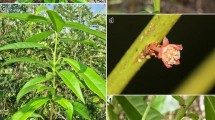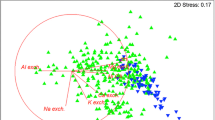Abstract
Five nickel hyperaccumulators belonging to the Asteraceae are known from ultramafic outcrops in South Africa. Phytoremediation applications of the known hyperaccumulators in the Asteraceae, such as the indigenous Berkheya coddii Roessler, are well reported and necessitate further exploration to find additional species with such traits. This study targeted the most frequently occurring species of the Asteraceae on eight randomly selected serpentinite outcrops of the Barberton Greenstone Belt. Twenty species were sampled, including 12 that were tested for nickel accumulation for the first time. Although the majority of the species were excluders, the known hyperaccumulators Berkheya nivea N.E.Br. and B. zeyheri (Sond. & Harv.) Oliv. & Hiern subsp. rehmannii (Thell.) Roessler var. rogersiana (Thell.) Roessler hyperaccumulated nickel in the leaves at expected levels. A new hyperaccumulator of nickel was discovered, Senecio conrathii N.E.Br., which accumulated the element in its leaves at 1695 ± 637 µg g−1 on soil with a total and exchangeable nickel content of 503 mg kg−1 and 0.095 µg g−1, respectively. This makes it the third known species in the Senecioneae of South Africa to hyperaccumulate nickel after Senecio anomalochrous Hilliard and Senecio coronatus (Thunb.) Harv., albeit it being a weak accumulator compared with the latter. Seven tribes in the Asteraceae have now been screened for hyperaccumulation in South Africa, with hyperaccumulators only recorded for the Arctoteae and Senecioneae. This suggests that further exploration for hyperaccumulators should focus on these tribes as they comprise all six species (of 68 Asteraceae taxa screened thus far) to hyperaccumulate nickel.



Similar content being viewed by others
References
Borhidi A (2001) Phylogenetic trends in Ni-accumulating plants. S Afr J Sci 97:544–547
Boyd RS (2004) Ecology of metal hyperaccumulation. New Phytol 162:563–567
Boyd RS, Davis MA, Balkwill K (2008) Elemental patterns in Ni hyperaccumulating and non-hyperaccumulating ultramafic soil populations of Senecio coronatus. S Afr J Bot 74:158–162
Brooks RR, Radford CC (1978) Nickel accumulation by European species of the genus Alyssum. Proc R Soc B-Biol Sci 200:217–224
Burge DO, Barker WR (2010) Evolution of nickel hyperaccumulation by Stackhousia tryonii (Celastraceae), a serpentinite-endemic plant from Queensland, Australia. Aust Syst Bot 23:415–430
Cecchi L, Gabbrielli R, Arnetoli M, Gonnelli C, Hasko A, Selvi F (2010) Evolutionary lineages of nickel hyperaccumulation and systematics in European Alysseae (Brassicaceae): evidence from nrDNA sequence data. Ann Bot 106:751–767
Chaney RL, Reeves RD, Baklanov IA, Centofanti T, Broadhurst CL, Baker AJM, Van der Ent A, Roseberg RJ (2014) Phytoremediation and phytomining: using plants to remediate contaminated or mineralized environments. In: Rajakaruna N, Boyd RS, Harris TB (eds) Plant ecology and evolution in harsh environments. Nova Science Publishers, New York, pp 365–392
Ellery KS, Walker BH (1986) Growth characteristics of selected plant species on asbestos tailings from Msauli Mine, Eastern Transvaal. S Afr J Bot 52:201–206
Ernst WH (2006) Evolution of metal tolerance in higher plants. For Snow Landsc Res 80:251–274
Gabbrielli R, Pandolfini T (1984) Effect of Mg2+ and Ca2+ on the response to nickel toxicity in a serpentine endemic and nickel-accumulating species. Physiol Plant 62:540–544
Galey ML, Van der Ent A, Iqbal MCM, Rajakaruna N (2017) Serpentine geoecology of South and Southeast Asia. Bot Stud 58:18
Gall JE, Rajakaruna N (2013) The physiology, functional genomics, and applied ecology of heavy metal-tolerant Brassicaceae. In: Lang M (ed) Brassicaceae: characterisation, functional genomics and health benefits. Nova Sciences Publishers, New York, pp 121–148
Hughes JC, Noble AD (1991) Extraction of chromium, nickel and iron and the availability of chromium and nickel to plants from serpentine derived soils from the Eastern Transvaal as revealed by various single and sequential extraction techniques. Commun Soil Sci Plan 22:1753–1766
Jaffré T, Pillon Y, Thomine S, Merlot S (2013) The metal hyperaccumulators from New Caledonia can broaden our understanding of nickel accumulation in plants. Front Plant Sci 4:279
Koekemoer M (1996) An overview of the Asteraceae of southern Africa. In: Hind DJN, Beentje HJ, Smith SAL (eds) Compositae: systematics. Proceedings of the international compositae conference, vol 1. Royal Botanic Gardens, Kew, pp 95–110
Kruckeberg AR, Kruckeberg AL (1990) Endemic metallophytes: their taxonomic, genetic, and evolutionary attributes. In: Shaw AJ (ed) Heavy metal tolerance in plants: evolutionary aspects. CRC Press, Boca-Raton, pp 301–312
Mengoni A, Baker AJM, Bazzicalupo M, Reeves RD, Adigüzel N, Chianni E, Galardi F, Gabbrielli R, Gonnelli C (2003) Evolutionary dynamics of nickel hyperaccumulation in Alyssum revealed by ITS nrDNA analysis. New Phytol 159:691–699
Mesjasz-Przybylowicz J, Przybylowicz WJ, Rama DBK, Pineda CA (2001) Elemental distribution in Senecio anomalochrous, a Ni hyperaccumulator from South Africa. S Afr J Sci 97:593–595
Mesjasz-Przybyłowicz J, Barnabas A, Przybyłowicz W (2007) Comparison of cytology and distribution of nickel in roots of Ni-hyperaccumulating and non-hyperaccumulating genotypes of Senecio coronatus. Plant Soil 293:61–78
Morgenthal T, Maboeta M, Van Rensburg L (2004) Revegetation of heavy metal contaminated mine dumps using locally serpentine-adapted grassland species. S Afr J Bot 70:784–789
Morrey DR, Balkwill K, Balkwill M-J (1989) Studies on serpentine flora: preliminary analyses of soils and vegetation associated with serpentinite rock formations in the south-eastern Transvaal. S Afr J Bot 55:171–177
Nishida S, Tsuzuki C, Kato A, Aisu A, Yoshida J, Mizuno T (2011) AtIRT1, the primary iron uptake transporter in the root, mediates excess nickel accumulation in Arabidopsis thaliana. Plant Cell Physiol 52:1433–1442
Proctor J (1971) The plant ecology of serpentine: III. The influence of a high magnesium/calcium ratio and high nickel and chromium levels in some British and Swedish serpentine soils. J Ecol 59:827–842
Rajakaruna NB, Harris TB, Alexander EB (2009) Serpentine geoecology of eastern North America: a review. Rhodora 111:21–108
Rascio N, Navari-Izzo F (2011) Heavy metal hyperaccumulating plants: how and why do they do it? And what makes them so interesting? Plant Sci 180:169–181
Reeves RD, Adigüzel N (2004) Rare plants and nickel accumulators from Turkish serpentine soils, with special reference to Centaurea species. Turk J Bot 28:147–153
Reeves RD, Baker AJM (2000) Metal-accumulating plants. In: Raskin I, Ensley BD (eds) Phytoremediation of toxic metals: using plants to clean up the environment. Wiley, New York, pp 193–229
Reeves RD, Baker AJM, Borhidi A, Berazain R (1999) Nickel hyperaccumulation in the serpentine flora of Cuba. Ann Bot 83:29–38
Robinson BH, Brooks RR, Howes AW, Kirkman JH, Gregg PEH (1997) The potential of the high-biomass nickel hyperaccumulator Berkheya coddii for phytoremediation and phytomining. J Geochem Explor 60:115–126
Robinson BH, Brooks RR, Clothier BE (1999) Soil amendments affecting nickel and cobalt uptake by Berkheya coddii: potential use for phytomining and phytoremediation. Ann Bot 84:689–694
Sabienë N, Brazauskienë DM, Rimmer D (2004) Determination of heavy metal mobile forms by different extraction methods. Ekologija 1:36–41
Schöning A, Brümmer GW (2008) Extraction of mobile element fractions in forest soils using ammonium nitrate and ammonium chloride. J Plant Nutr Soil Sci 171:392–398
Severne BC (1974) Nickel accumulation by Hybanthus floribundus. Nature 248:807–808
Shallari S, Schwartz C, Hasko A, Morel JL (1998) Heavy metals in soils and plants of serpentine and industrial sites of Albania. Sci Total Environ 209:133–142
Sharma SS, Dietz KJ (2006) The significance of amino acids and amino acid-derived molecules in plant responses and adaptation to heavy metal stress. J Exp Bot 57:711–726
Siebert SJ, Van Wyk AE, Bredenkamp GJ (2002) The physical environment and major vegetation types of Sekhukhuneland, South Africa. S Afr J Bot 68:127–142
Smith S, Balkwill K, Williamson S (2001) Compositae on serpentine in the Barberton Greenstone Belt, South Africa. S Afr J Sci 97:518–520
Van der Ent A, Baker AJM, Reeves RD, Pollard AJ, Schat H (2013) Hyperaccumulators of metal and metalloid trace elements: facts and fiction. Plant Soil 362:319–334
Van der Ent A, Erskine P, Sumail S (2015) Ecology of nickel hyperaccumulator plants from ultramafic soils in Sabah (Malaysia). Chemoecology 25:243–259
Acknowledgements
Mr Arnold Frisby from the University of Pretoria is thanked for assistance with fieldwork. Dr Marinda Koekemoer from the Pretoria National Herbarium confirmed the identity of the hyperaccumulator. Prof Marthie Coetzee from the North-West University confirmed the rock samples as serpentinite. National Geographic Society funded the fieldwork and the Botanical Education Trust funded the plant and soil analyses conducted at the labs of EcoAnalytica at the North-West University. We thank two anonymous reviewers for their constructive comments which helped in improving the manuscript. Opinions expressed and conclusions arrived at, are those of the authors and are not necessarily to be attributed to the funders. The authors declare that they have no conflict of interest.
Author information
Authors and Affiliations
Corresponding author
About this article
Cite this article
Siebert, S.J., Schutte, N.C., Bester, S.P. et al. Senecio conrathii N.E.Br. (Asteraceae), a new hyperaccumulator of nickel from serpentinite outcrops of the Barberton Greenstone Belt, South Africa. Ecol Res 33, 651–658 (2018). https://doi.org/10.1007/s11284-017-1541-5
Received:
Accepted:
Published:
Issue Date:
DOI: https://doi.org/10.1007/s11284-017-1541-5




